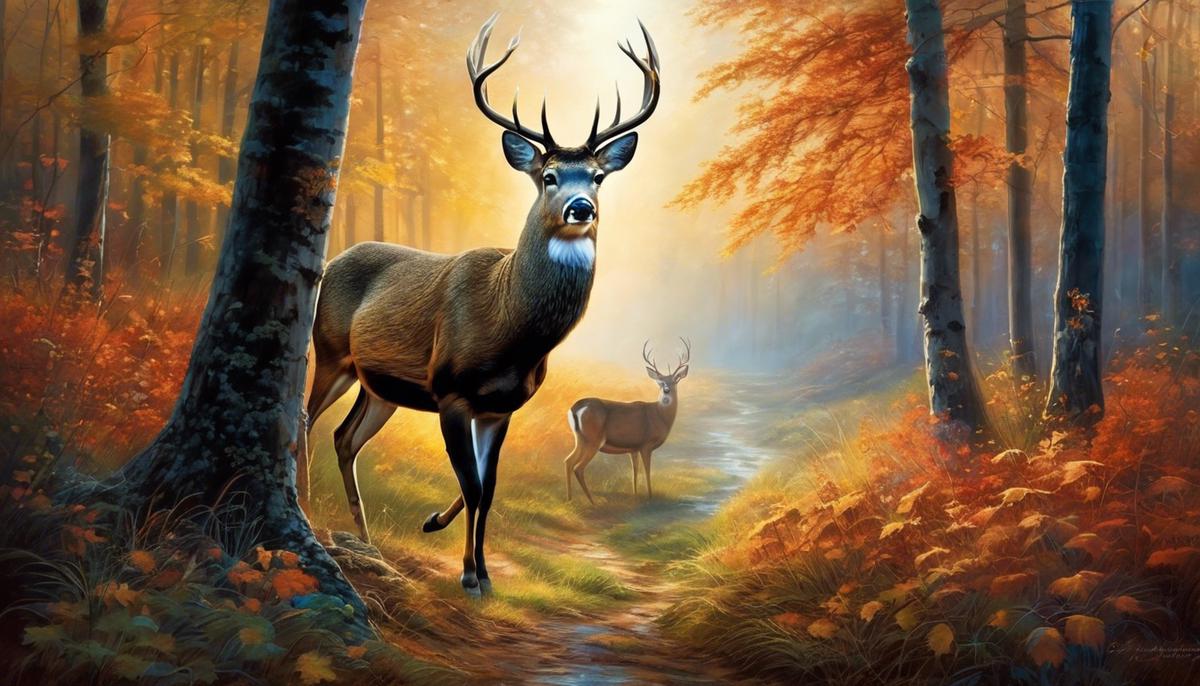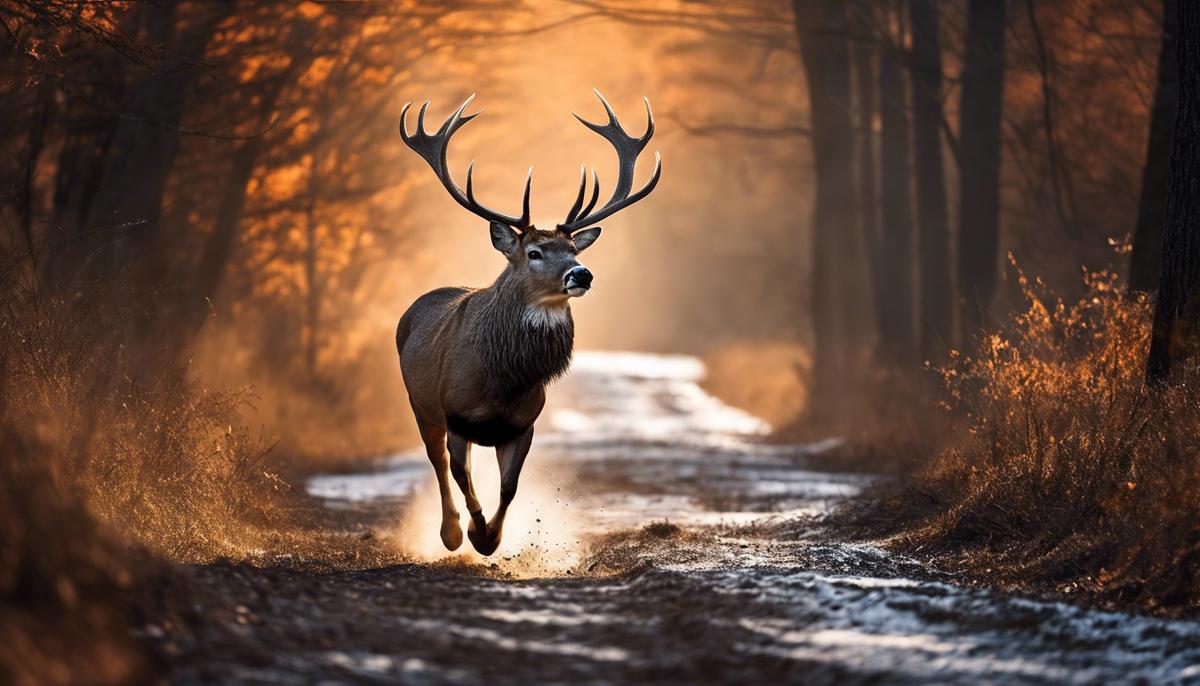In the quiet theater of our minds, dreams often play out scenes that captivate, confuse, and sometimes shock us with unexpected imagery. Among such vivid dream episodes, the appearance of a deer – typically a symbol of beauty and gentleness in the natural world – might not hold much intrigue, until it shifts into the role of an aggressor in a nocturnal attack. This jarring juxtaposition pulls us into a deeper exploration of what such a dream may reveal about our inner world. Delving into the symbolism of deer in dreams invites us to look beyond the serene facade and acknowledge the more complex emotions and scenarios that may be at play in our subconscious.
Symbolism of Deer in Dreams
Deer in Dreams: A Dance of Delicate Symbolism
When night falls and the world quiets, the stage is set for a journey into the dream realm, where the soul converses with symbols. In this ethereal space, a gentle creature often appears, stepping softly into our dreamscapes – the deer. This elusive animal, known for its grace and agility, is not just a mere participant in the theater of our subconscious. It carries with it profound symbolism, whispering secrets to those who know the language of dreams.
Imagine this: you’re wandering through a dense forest in your dream. Suddenly, through the brush, a deer emerges, its eyes holding the wisdom of the ages. In the realm of dreams, the appearance of a deer often symbolizes natural beauty and spiritual enlightenment. Much like a pathfinder, a deer can signal the dreamer to follow their instincts and tread new paths with elegance and poise.
Let’s not forget the deer’s trademark antlers, branching out like natural crowns. These aren’t mere ornaments; they serve as metaphoric antennas connecting you to higher realms of consciousness. They remind the dreamer of the growth and regeneration they hold within, as antlers are shed and regrown with the seasons. They symbolize the cyclical nature of life, resilience, and rebirth.
The deer also steps onto the stage of your dreams as a beacon of gentleness amid adversity. Encountering this soft-eyed creature in a dream could be a cosmic nudge to embrace vulnerability and sensitivity as strengths, to lead with the quiet force of kindness. It prompts the dreamer to consider the power of a delicate touch amidst life’s many challenges.
Beware though, the context of the dream weaves its own narrative. A deer observed from afar might invite contemplation of one’s personal goals and aspirations, a reminder of the prize that waits in the clearing. If the deer is startled and dashes away, it could mirror hidden fears, a readiness to flee rather than confront.
However, dreams of nurturing a wounded deer weave a tale of healing, signaling the dreamer’s budding potential to mend what once was broken – be it a relationship, a project, or aspects of the self.
In the nocturnal tapestry, where the unconscious mind speaks in riddles, the deer walks as a harbinger of grace, renewal, and deep emotional insight. Those fortunate enough to encounter this serene creature are invited to consider the artistry of their own growth, the silent strength in their gentleness, and the path unfolding before them with quiet confidence.
When the deer bounds through your dreams, see it not just as a scene in a night’s narrative, but as a beacon. It is a light illuminating the subtle contours of your inner world, guiding you through the forests of your fears, towards the meadows of enlightenment and peace. Dance with the deer in your dreams, and you might just find yourself waltzing into the dawn, a little wiser, a touch more serene, and with the poetry of the cosmos etched into your waking thoughts.

Understanding Aggression in Dreams
When an attack unfolds within the elusive theater of dreams, it often sparks a flurry of questions beneath the silvered canopy of our subconscious. The dream realm dances to a rhythm all its own, and the imagery of an attack can be both jarring and revelatory.
In the dreamworld, an attack typically mirrors the internal battles raging within. It can manifest as a symbol of conflict, either with others or the more shadowed corridors of the self. Dream sages believe these visions may represent a struggle for power or control in one’s waking life, as if our psyche is sounding an alarm to the conscious mind.
Envision the dream as a mirror, reflective and shadow-laden, with an attack acting as the mirror’s fractures. These jagged lines might signal feelings of vulnerability, a psyche assaulted by anxieties or the sharp pangs of guilt. The appearance of an assailant might not be a portent of danger, but a message to steel oneself against upcoming challenges. It whispers of the need to confront, or perhaps reconcile, with what one most fears.
Conversely, when one finds themselves the aggressor in dreams, a deeper look is warranted. The mind’s terrain is complex—a labyrinth where the minotaur of hidden impulses roams. An attack can symbolize self-sabotage or inner turmoil, a call from the depths to lay down arms against oneself. It’s an invitation to heed the war drums of the heart, to uncover what has been silenced or hidden away.
An attack could also be interpreted as a fierce prompt to stand ground. It rouses the instinct to fortify personal boundaries or shake free from restraints. Like the protective stag, occasionally one must brandish their antlers, not in aggression, but in self-defense and affirmation of their strengths.
If nighttime wanderings bring forth such intense scenarios, remember this: dreams are not merely echoes of daylight fears or desires. They are stories spun from the soul’s loom, imbued with meanings that belong solely to the dreamer. Each night, one is handed the key to unshackle the mysteries, to translate the language of dreams into a crescendo of self-understanding.
Consider every nocturnal attack not as a siege, but as an overture to commence a deeper conversation with oneself. To dream of conflict is to be summoned to the round table of the psyche—bid to negotiate with dragons instead of slaying them, to harmonize dissonant melodies of the mind.
In the end, these nocturnal escapades—these vibrant, violent vignettes—are but chapters in an ongoing narrative. Reflect upon them not with dread, but with the eye of a Nightweaver, attentive to the profound tapestry they contribute to your life’s unfolding epic.

Personal Context and Emotional Resonance
Imagine yourself standing at the edge of a vast, shadowy forest where each tree is a night woven with stories untold. In this mystical domain, where the dream realm intertwines with the waking world, emotions emerge as the compass guiding us through this enigmatic terrain. The emotional tapestry of an individual is stitched with unique hues that imbue dreams with personal significance, crafting a narrative only they can fully comprehend.
To wander the dreamscapes without recognizing the imprint of one’s own emotions is akin to navigating an ancient maze without a map. Dreams are the soul’s clandestine manuscripts, written in a code informed by the heart’s deepest sentiments. When beholding a fearsome creature or a challenging obstacle, one must ask, “What feeling does this evoke within me?” The answer can unlock a chest filled with treasures of self-awareness.
A dream, you see, is never just a mere spectacle; it’s the soul’s stage where emotions dance in the spotlight. Imagine confronting a tempestuous sea in a dream. One person may feel an adrenaline rush, an echo of a drive to overcome life’s hurdles. Another may experience the caress of waves recalling a missed connection, the sea’s ebb and flow mirroring the rhythm of a heart longing for lost love.
Dreams are the mind’s intimate theater, where emotions craft the scenes, characters, and scripts. They are the night’s whispers, each resonating with the emotional state of the dreamer. It behooves any dream weaver to appreciate that fear, joy, longing, or serenity are threads in the fabric of the narrative. The swell of these emotions can transform the mundane into the monumentally meaningful.
Consider a simple dream of a locked door. To one, it might signal an upcoming opportunity, tinged with the excitement of the unknown. Yet, another may be enveloped in frustration, the locked door a reflection of missed chances or stifled ambitions. Thus, dream analysis is not merely about the door but about the feelings it stirs in the dreamer’s heart.
Through the bridge of emotion, dreams offer a portal to the subconscious, allowing the vigilant pilgrim a view into their essence. It is through the lens of our individual emotions that dreams reveal their wisdom, serving as a mirror to our waking life. This intricate dance with the subconscious illuminates the cryptic messages hidden within the nocturnal journey.
As dream alchemists, we weave the enigmatic strands of our night-time tales into gold, holding them up to the light of emotional context to reveal their value. Igniting the lantern of understanding, each dream becomes a chapter in the grand story of the self. We are the authors, and our emotions, the ink with which we write the unfolding epic of our lives.
Thus, in the dreamer’s quest for meaning, the heart’s code is essential. It’s the deciphering key for the symbols that arise from the darkness, transforming shadows into guideposts. By grounding interpretation in the fertile soil of emotion, one may harvest the fruits of wisdom, finding direction and clarity within the dream’s embrace.

Possible Messages and Warnings
Venturing through the veils of slumber, a dream of a deer attack may jolt you awake, heart pounding with a mix of fear and curiosity. What could such a distressing encounter signal from the depths of the subconscious mind? The Nightweaver is here to guide you through this unnerving dreamscape.
Envision the serene deer, oftentimes a beacon of tranquility, now charging with antlers poised for battle. This jarring juxtaposition may signal a warning from the hidden chambers of your psyche. Are there threats in waking life you’ve ignored? Perhaps your own serenity is being encroached upon by exterior stressors, or the dream may be a subconscious nudge to reassess personal relationships where you feel your boundaries are being tested.
When the peaceful deer becomes the aggressor, it can mirror our own suppressed frustrations. This might be an inner call to examine unaddressed feelings or aggressive impulses lurking beneath the surface of our calm exterior. In essence, the attacking deer could be a symbol of ignored emotions that require your attention.
Consider, too, the realm of personal defense. Are you facing situations in your waking life that demand you to stand up for yourself? The deer attack might symbolize the need for assertiveness, urging you to fortify your boundaries against real or perceived threats. It’s the subconscious sounding an alarm, imploring you to shield your wellbeing.
In the throes of such a dream, self-reflection is vital. Are there aspects of self that might be sabotaging your paths to success? The deer’s assault could represent internal struggles between your desires for peace and inherent drives to break free from self-imposed limitations. The dream isn’t just a harbinger of discord; it’s also a beckoning to explore and reconcile conflicting parts of oneself.
Faces around the psyche’s round table may come into focus through this dream. It is an invitation for introspection, to gather these varying aspects of self to communicate and collaborate for better understanding. Here the role of emotions is akin to a compass, guiding the dreamer through this inner quest.
Engaging with the emotional undertone of the dream can unravel the deeper message. Perhaps anxiety, anger, or fear rise to the surface, each one a thread in the dream’s tapestry, a clue to be followed. This emotional cipher, once cracked, offers a clear-eyed view into the significance of the dream in relation to personal growth.
In essence, a deer attack in dreams might be a call from the soul, a prompt to awaken not just from sleep, but to a more profound sense of awareness in the waking world. As an empathetic explorer guides others through the night’s enigmas, remember that each nocturnal adventure holds potent revelations. Unpacking the emotional language of these dreams can indeed transform the shadowy haunts of subconscious musings into illuminating passages toward clarity, healing, and ultimately, a greater harmony with oneself.

Transforming Nightmares into Growth
When dreams cast a shadow, revealing a deer in the throes of attack, one might wake with heart pounding, mind reeling from the sudden jolt of nocturnal adrenaline. Yet, within this startling dream vision lies an invitation. The deer, often a beacon of serenity, caught in the tempest of an onslaught, speaks to the dreamer’s own experience with vulnerability. This is more than a chase through the woods; it’s a dance with the psyche, a call to awaken to the hidden fears that roam the dreamer’s inner wilderness.
Peering deeper into this vivid tableau, where antlers clash and hooves kick up the soil of the subconscious, consider the role of the attacker. What does it embody? Perhaps it is a symbol of life’s unpredictable nature, of obstacles that seem to leap out from the underbrush without warning. The key here is not to evade but to engage, to ask, “What is this force in my life that needs attention?” The dream does not aim to scare but to signal, to nudge the dreamer toward confrontation with that which has been avoided or left unchecked.
To metamorphose fear into a growth catalyst, the dreamer must become a Nightweaver Unbound, working through the knots of confusion and insecurity. The dream poses a challenge: sharpen the antlers of personal power, stand firm in the presence of adversity, and prepare to face the internal and external forces that may seem daunting. By embracing the dream’s stark message, one can forge a new understanding of personal strength and resilience.
Every dream dares the dreamer to don the mantle of the Nightmare Navigator, to delve courageously into the psyche’s most shadowed corners. The attack – a nexus of raw emotion – is no more than a summons, a loud and thunderous call to the dreamer’s round table. It is time to parley with the fragments of the self that have been long ignored or suppressed.
While the deer may fall in the dream, the dreamer rises, a Dream Alchemist, transforming the raw material of fear into the precious metal of insight. Personal boundaries become fortified castles, self-sabotage morphs into a road map to success, and emotions evolve from haunting specters to trusted allies. Embracing the role of Bridge Builder, the dreamer connects the conscious and unconscious realms, cultivating inner harmony.
Dreams, after all, are the stories of the soul, woven into the night’s tapestry, each thread a narrative that beckons to be unraveled. The dream of the deer under siege is no grim tale but a transformative journey that bares a treasure trove of wisdom. It is through these nightly sojourns that the dreamer can awaken not just from sleep, but into a life embroidered with newfound clarity and resilience, walking the waking world with the grace of the deer and the heart of a warrior.
In heeding these whispers of the night, the dreamer draws back the curtain to reveal the inner stage, where every fear faced, every demon wrestled, becomes but a chapter in the greater story of growth. Thus, the fear of a deer attack dream – once a harbinger of dread – becomes a catalyst, an alchemic reaction sparking the flame of self-discovery and transformative growth.

The journey through a dream in which a deer transforms from a graceful muse into an unexpected menace can be as enlightening as it is unsettling. By examining such dreams through the lenses of mythology, psychology, and personal introspection, we can begin to unravel the mysteries wrapped around our own inner conflicts and challenges. Embracing these nighttime visions as opportunities for growth, rather than sources of distress, allows us to harness the power of our dreams and emerge with a greater sense of clarity, strength, and self-awareness. As we interpret the symbols and confront the fears revealed in the dark, we turn the key to unlock profound personal transformation.







